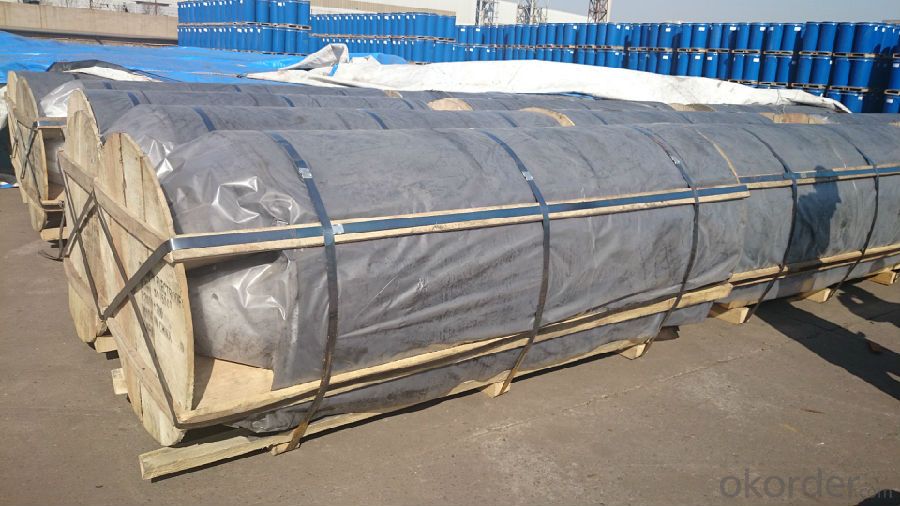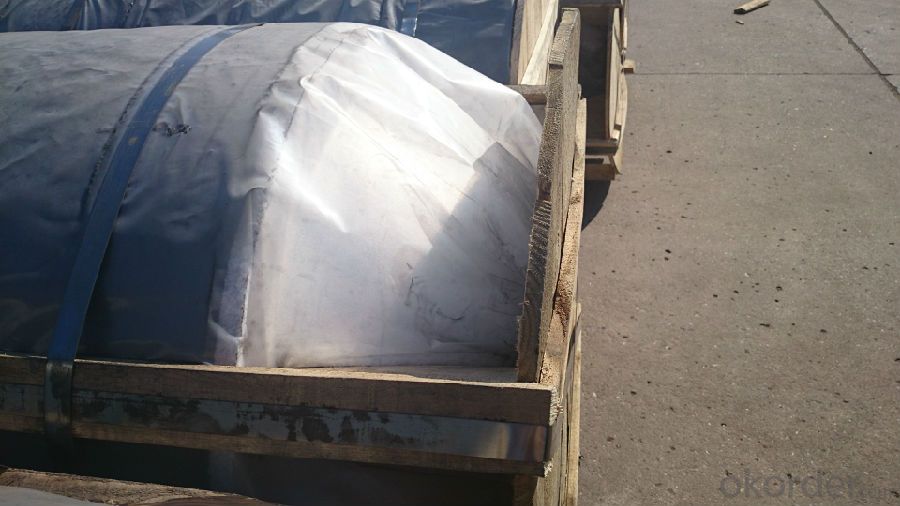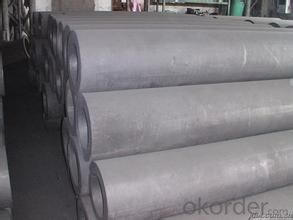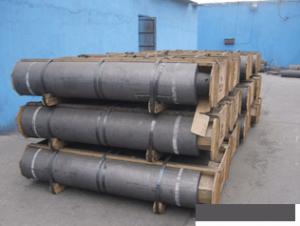Carbon Electrode for Silicon Furnace Usage
- Loading Port:
- Tianjin
- Payment Terms:
- TT OR LC
- Min Order Qty:
- 20 m.t.
- Supply Capability:
- 800 m.t./month
OKorder Service Pledge
OKorder Financial Service
You Might Also Like
Spcifications
1:carbon eletrode
2:for ferroalloy,calcium carbide, silicon metal, manufacture
Product Description
Carbon Electrode is abaked electrode used in submerged arc furnaces for delivering power to the charge mix. Electrode is added to the top of the electrode column cylindrical form. Electrode is essentially a mix of Electrically Calcined Anthracite (ECA) or Calcined Petroleum Coke (CPC) with Coal Tar Pitch and is baked for weeks, it is widly used for ferroally productiong, silicon metal production etc.
Graphite/Carbon Electrode Paste Specification:
| PARAMETER UNIT GUARANTEE VALUE | ||||||
| Items | Φ500~Φ700 | Φ750~Φ960 | Φ1020~Φ1400 | |||
| Rs μΩ.m | ≤45 | ≤38 | ≤45 | ≤38 | ≤40 | |
| Bulk Desity g/cm3 | ≥1.55 | ≥1.58 | ≥1.55 | ≥1.58 | ≥1.55 | ≥1.58 |
| Bending Strength MPa | 3.5~7.5 | 4.0~7.5 | 3.5~7.5 | 4.0~7.5 | 3.5~7.5 | 4.0~7.5 |
| Compressive Strength MPa | ≥20.0 | ≥20.0 | ≥20.0 | ≥20.0 | ≥19.0 | ≥19.0 |
| Compressive Strength MPa | 3.2~4.8 | 3.0~4.6 | 3.2~4.8 | 3.0~4.6 | 3.2~4.8 | 3.0~4.6 |
| Ash % | ≤2.5 | ≤2.0 | ≤2.5 | ≤2.0 | ≤2.5 | ≤2.0 |
Picture:




We Also supply all kind of carbon electrode paste and below materials, please contact us if you have any enquiry about it.
Calcined Anthracite
Calcined Petroleum Coke
Coke (Met Coke, Foundry Coke, Semi Coke)
Company Information:
China National Building Materials Group is a stated -owned enterprise in charge of administrative affairs in China buiding materials industry.Established in 1984 CNBM is a large group corporation of building materials with total assets of 25 billion and a total stuff of 30000 CNBM now owns 200 subordinating firms of solely owned and joint-venture companies.
- Q:How does carbon impact the prevalence of droughts?
- Carbon, specifically in the form of carbon dioxide (CO2) emissions, plays a significant role in the prevalence of droughts. The increase in carbon levels in the atmosphere contributes to global warming, which in turn affects the overall climate patterns worldwide. When carbon dioxide is released into the atmosphere through human activities such as burning fossil fuels and deforestation, it acts as a greenhouse gas. Greenhouse gases trap heat from the sun and prevent it from escaping back into space, causing the Earth's temperature to rise. As the global temperature increases, it leads to changes in precipitation patterns and evaporation rates. Warmer temperatures accelerate evaporation, causing more water to evaporate from lakes, rivers, and soil. This increased evaporation coupled with altered precipitation patterns results in drier conditions and reduced water availability in certain regions. Additionally, the rising temperatures contribute to the intensification of the water cycle, causing more extreme weather events. This includes more frequent and severe droughts, as well as intense rainfall in some areas, leading to increased risks of floods. Furthermore, carbon emissions also contribute to changes in atmospheric circulation patterns, such as the weakening of the jet stream. The jet stream is responsible for steering weather systems, including rain-bearing weather fronts, across the globe. When it weakens, weather systems tend to become stagnant, resulting in prolonged periods of drought in certain regions. Overall, the increased levels of carbon in the atmosphere due to human activities have a direct impact on global warming and climate change. These changes in climate patterns and atmospheric circulation, combined with the intensification of the water cycle, significantly influence the prevalence and severity of droughts worldwide. Therefore, reducing carbon emissions and mitigating climate change is crucial in addressing and minimizing the impacts of droughts on ecosystems, agriculture, and human populations.
- Q:What kinds of barbecue carbon do you have?
- The carbon has uniform size, long burning time, uniform fire, no smoke and no expensive price. Many professional barbecue shops choose this kind of carbon. The disadvantage is that it should not ignite. If only two or three people barbecue, with this carbon, then people are full, carbon has not used up, can not help but feel a little wasted.
- Q:How does carbon affect the stability of ecosystems?
- Carbon plays a crucial role in the stability of ecosystems. It is a fundamental element that is essential for all living organisms. Carbon is present in the atmosphere, in the form of carbon dioxide (CO2), and is absorbed by plants during photosynthesis. This process allows plants to convert sunlight, water, and carbon dioxide into glucose, which is then used as energy for growth and development. The stability of ecosystems heavily relies on the balance of carbon in the environment. Carbon acts as a building block for organic matter and is stored in various forms such as plants, animals, soil, and the atmosphere. This storage of carbon helps to regulate the carbon cycle, which is crucial for maintaining a stable climate. One of the main ways carbon affects the stability of ecosystems is through its role in climate regulation. Carbon dioxide is a greenhouse gas, meaning it traps heat in the atmosphere and contributes to global warming. Excessive carbon emissions from human activities, such as burning fossil fuels, deforestation, and land-use changes, have led to an increase in carbon concentration in the atmosphere. This results in the enhanced greenhouse effect, leading to rising temperatures and climate change. Climate change has far-reaching consequences for ecosystems. It can disrupt the delicate balance of ecosystems by causing shifts in temperature and precipitation patterns, altering habitats, and affecting the timing of seasonal events. These changes can lead to the loss of biodiversity, as certain species may struggle to adapt to the new conditions. Additionally, climate change can also impact the availability of resources, such as water and food, which are essential for the functioning and stability of ecosystems. Furthermore, the excessive release of carbon into the atmosphere can also have direct negative effects on ecosystems. Acid rain, caused by high levels of carbon emissions, can lead to the acidification of water bodies, making them unsuitable for aquatic life. Increased carbon dioxide levels in the oceans can also lead to ocean acidification, which harms marine organisms like corals and shellfish. On the other hand, carbon is also essential for the health and productivity of ecosystems. Carbon-rich organic matter in the soil helps to retain nutrients, improve soil structure, and enhance water-holding capacity. This enables plants to grow better and supports the overall functioning of ecosystems. In conclusion, carbon has a profound impact on the stability of ecosystems. While it is necessary for the growth and development of living organisms, excessive carbon emissions and climate change pose significant threats to the balance and functioning of ecosystems. It is crucial to reduce carbon emissions, promote sustainable practices, and protect carbon sinks like forests and wetlands to ensure the long-term stability of ecosystems.
- Q:What is the starting temperature and final forging temperature of carbon steel?
- Forging temperature range refers to a temperature interval between the initial forging temperature and forging temperature. To determine the basic principles of forging temperature, can ensure that the metal has a high plasticity and low deformation resistance in the forging temperature range, and organization and performance requirements.
- Q:Where are carbon fiber sheets and carbon fiber sheets used?
- Carbon reinforced materials, carbon fiber cloth is mainly used for concrete beam flexural and shear strengthening, flexural reinforcement, column reinforcement plate; plant, buildings, schools, hospitals and other industrial and civil building reinforcement; Luqiao, water conservancy, nuclear power and energy infrastructure reinforcement.Carbon fiber board is mainly used for concrete structure plate and beam repairing and reinforcing plate; opening wall and surrounding reinforcement; the wooden building beam reinforcement; reinforced bridge, bridge pier, truss; tunnel, cable pipeline repairing and reinforcing.
- Q:What is the carbon content of different types of soil?
- The carbon content of different types of soil can vary significantly depending on factors such as vegetation cover, climate, and land use. Generally, soils with abundant plant growth and organic matter tend to have higher carbon content. For example, forest soils typically have higher carbon content compared to agricultural or desert soils. Additionally, the carbon content can vary within soil profiles, with surface layers often containing more carbon than deeper layers.
- Q:How does carbon affect the formation of avalanches?
- The formation of avalanches is not directly affected by carbon. Rather, factors such as snowpack stability, slope angle, and weather conditions primarily contribute to their occurrence. Nevertheless, avalanche formation can be indirectly influenced by carbon emissions and climate change, which impact snowpack stability. Increased levels of carbon dioxide in the atmosphere contribute to global warming, consequently affecting the overall climate. This warming leads to changes in precipitation patterns, snowfall amounts, and snowpack characteristics. Higher temperatures can cause rain instead of snow, resulting in a less stable snowpack. Climate change, in addition to altered precipitation patterns, can cause the melting and refreezing of snow. This process creates weak layers within the snowpack. When combined with subsequent snowfall and wind, these weak layers can lead to unstable snowpacks that are prone to avalanches. Moreover, carbon emissions contribute to the overall warming of the planet, which in turn can lead to the retreat of glaciers. Glaciers act as natural barriers and stabilizers in mountainous regions, reducing the likelihood of avalanches. However, as glaciers shrink, they leave behind unstable slopes, thereby increasing the potential for avalanches. It is important to emphasize that while carbon emissions and climate change indirectly influence avalanche formation, they are not the primary or sole cause. Local weather conditions, slope angles, and snowpack stability assessments conducted by avalanche experts play a more immediate role in determining the likelihood of avalanches.
- Q:How is carbon used in the production of lubricants?
- Lubricants are produced using carbon in various ways. Base oil is one of the primary applications of carbon in lubricant production. Lubricants mainly consist of carbon-based molecules like mineral oils, synthetic oils, and vegetable oils. These oils are either obtained from crude oil or synthesized from other carbon-rich compounds. The base oil contains carbon atoms that form long chains or rings, offering exceptional lubricating properties. These carbon chains or rings possess high viscosity, reducing friction between moving parts. Consequently, this minimizes wear and tear, heat generation, and energy loss in different mechanical systems. Carbon is also utilized to create additives for lubricants. These additives are added to the base oil to improve its performance and provide additional advantages. For instance, graphite and molybdenum disulfide are carbon-based additives that deliver superior lubrication under extreme pressures and temperatures. They create a protective layer on the surface of moving parts, decreasing friction and preventing metal-to-metal contact. Moreover, carbon-based additives can enhance the oxidation resistance and anti-wear characteristics of lubricants. By introducing carbon molecules with specific functional groups, lubricants acquire the ability to form a protective film on metal surfaces. This film prevents corrosion and extends the lifespan of machinery. In conclusion, carbon plays a vital role in lubricant production. It acts as the base oil, providing viscosity and lubricating properties, and serves as an additive to optimize performance and safeguard machinery. Without carbon, the production of effective lubricants would be impossible.
- Q:How does carbon impact the ozone layer?
- Carbon does not directly impact the ozone layer. However, certain carbon compounds, such as chlorofluorocarbons (CFCs), can contribute to ozone depletion when released into the atmosphere.
- Q:What is the carbon content of different fuels?
- The carbon content of different fuels can vary significantly depending on their composition and source. However, in general, fossil fuels such as coal, oil, and natural gas have high carbon content. Coal, which is primarily composed of carbon, typically contains around 60-80% carbon. This makes coal a highly carbon-intensive fuel and a major contributor to greenhouse gas emissions when burned. Crude oil and petroleum products, such as gasoline and diesel, also have high carbon content, ranging from 80-90%. When these fuels are burned, they release significant amounts of carbon dioxide (CO2) into the atmosphere. Natural gas, consisting mainly of methane (CH4), has a lower carbon content compared to coal and oil. Methane itself is composed of one carbon atom and four hydrogen atoms, resulting in a carbon content of around 75%. Although natural gas emits less CO2 when burned compared to coal and oil, methane itself is a potent greenhouse gas, which can contribute to climate change. Renewable fuels, such as biofuels, have varying carbon contents depending on their source. Biofuels are derived from organic materials, such as plants and agricultural waste, and can have carbon contents similar to fossil fuels. However, since biofuels are derived from recently living organisms, the carbon dioxide emitted during their combustion is considered part of the natural carbon cycle and does not contribute to long-term increases in atmospheric CO2 levels. Overall, the carbon content of different fuels is an important factor in determining their environmental impact and contribution to climate change. Transitioning to low-carbon or carbon-neutral fuels is crucial in reducing greenhouse gas emissions and mitigating the effects of climate change.
1. Manufacturer Overview |
|
|---|---|
| Location | |
| Year Established | |
| Annual Output Value | |
| Main Markets | |
| Company Certifications | |
2. Manufacturer Certificates |
|
|---|---|
| a) Certification Name | |
| Range | |
| Reference | |
| Validity Period | |
3. Manufacturer Capability |
|
|---|---|
| a)Trade Capacity | |
| Nearest Port | |
| Export Percentage | |
| No.of Employees in Trade Department | |
| Language Spoken: | |
| b)Factory Information | |
| Factory Size: | |
| No. of Production Lines | |
| Contract Manufacturing | |
| Product Price Range | |
Send your message to us
Carbon Electrode for Silicon Furnace Usage
- Loading Port:
- Tianjin
- Payment Terms:
- TT OR LC
- Min Order Qty:
- 20 m.t.
- Supply Capability:
- 800 m.t./month
OKorder Service Pledge
OKorder Financial Service
Similar products
New products
Hot products




























